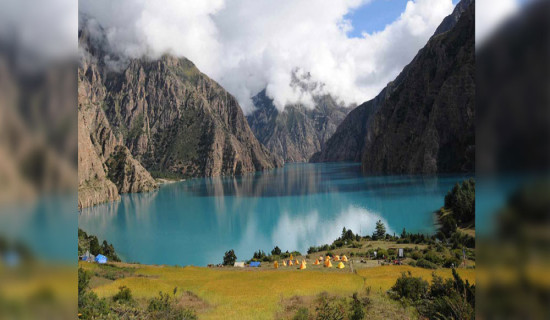- Wednesday, 10 December 2025
Mountain dwellers face grim prospect as springs dry up
Spring water plays a crucial role in sustaining life in the mountains. However, these essential water sources are drying up due to both natural and human-induced factors. The root causes of this c
Shermathan awaits tourists to occupy empty homestays
In the quiet village of Sermathan, nestled below the mountains in the Helambu Rural Municipality of Sindhupalchowk district, there are only a few children and aging elderly. The village silently awaits tourists to occupy its vacant houses.
Himalayan Snowcock spotted in Dhorpatan
The Himalayan Snowcock has been spotted for the first time in Dorpatan Hunting Range (DHR). A group of researchers including Hari Sharma, Associate Professor at the Central Department of Zoology, Tribhuvan University recorded the species for the first time shedding light on its distribution and habitat p
Long awaited winter rain, snowfall bring relief
The country experienced light to moderate rainfall along with heavy snowfall in various high mountainous areas across the country on Thursday. Some places in and around the Kathmandu Valley also received light snowfall.
2023 second warmest year for Nepal after 1981
The year 2023 was the second warmest year for Nepal, according to the Department of Hydrology and Meteorology (DHM). Earlier, 1981 was the hottest year after DHM started keeping the temperature record in Nepal from 1962.
National wetland policy lacks regulations
Various programmes were organised in the country to commemorate World Wetla
Snow leopard’s lowland foray leaves experts puzzled
In a small enclosure at the Central Zoo in Jawalakhel, Lalitpur, there is a snow leopard. It is the first time the ‘mountain ghost’ landed in the Zoo, brought there after being rescued from an unusual location.
Rescued snow leopard cub brought to Central Zoo
An injured snow leopard cub, rescued from Morang, was brought to the Central Zoo in Lalitpur on Wednesday. The young wild cat was found in Charghare of Urlabari Municipality-1 in Morang district on Tuesday.
Bagmati Corridor monuments restored to their original state
To enhance the beauty of the Bagmati River, 28 monuments along the river corridor were reconstructed, spanning from Teku Dovan to Thapathali. The monuments, which were damaged during the 2015 earthquake, have been reconstructed to restore a traditional appearance along the corridor. This initiative comes at a crucial time when various structures, including ghats, sattals, temples, shrines, and other related structures, have faced deterioration and disappearance.
Taudaha sees a tumble in winter water fowls
The water bird census in Kathmandu has revealed a concerning trend this year, with a noticeable decline in the number of birds found in and around Taudaha, Bagmati, and Manohara. Dr. Hem Sagar Baral, a pro
Challenges of fine tuning weather forecast accuracy
Despite the Department of Hydrology and Meteorology predicting above-normal rainfall for this winter (December to February) in its seasonal weather forecast, no rainfall has been recorded so far.
Nepal set to make millions through carbon trade
They say that money does not grow on trees, but Nepal is proving it wrong as it is poised to make significant financial gains through its forests. From its forests of 13 Ta
Addressing Nepal's Climate Vulnerability
Nepal, situated within the vulnerable Himalayan Mountain Range, is widely acknowledged as being susceptible to the effects of climate change. The June 2021 Melamchi River flood, triggered by increased northern region precipitation at the very onset of the monsoon, caused extensive loss of life and infrastructure. The August 2023 Kagbeni River flood, resulting from an upstream landslide, displaced 150 people and destroyed 29 houses. Moreover, a three-day post-monsoon rainfall in October 2021 incurred a record Rs. 8.26 billion losses, affecting 85,580 hectares of ready-to-harvest p
Wildlife menace common near Shivapuri National Park
People living in the vicinity of Shivapuri National Park near the capital city are troubled by wildlife menace. They have been dealing with the problems caused by monkeys and wild boars as the farmers of the remote villages.
Local cooling traced on Everest despite global warming
Mount Everest’s weather station has been found to be recording local cooling due to the effects of glaciers, an unusual phenomenon that contradicts with the overall trend of global warming. The findings published recently in the scientific journal Nature Geoscience shocked scientists when they revealed unexpectedly cool temperatures on the slopes of the highest peak. It goes against climate expectations and raises questions about the unique climate dynamics of Mt. Everest.
















